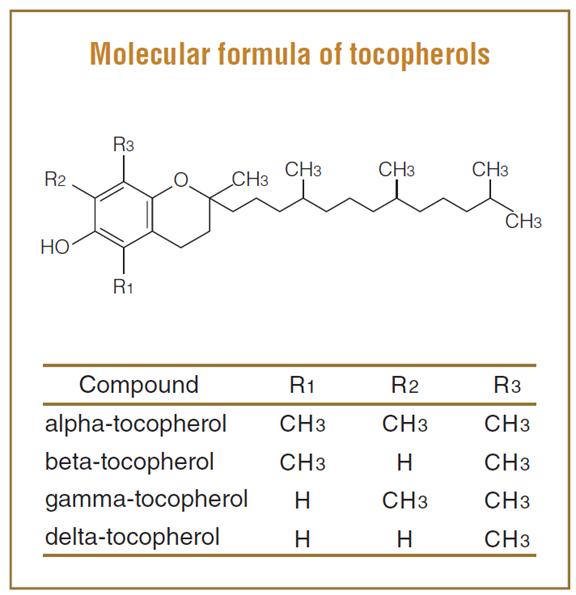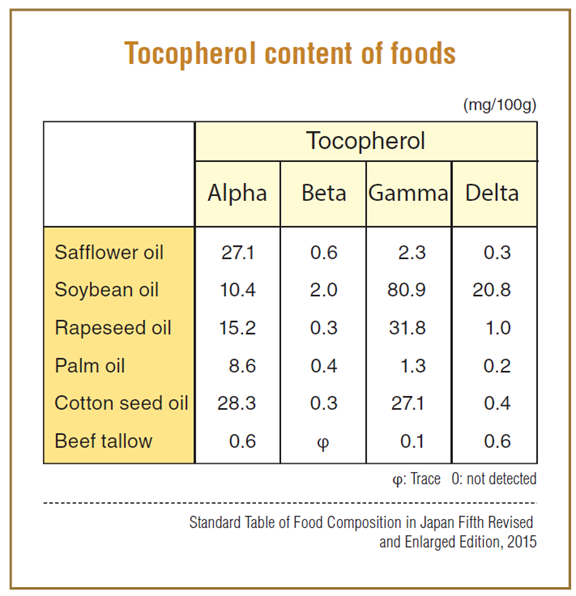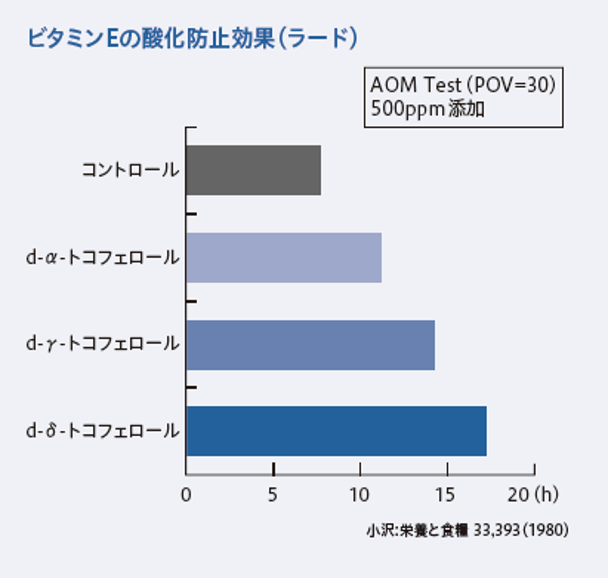
Vitamin E derived from plant origin
Vitamin E is produced using by-products from the manufacturing of edible vegetable oils as raw materials, and is manufactured through advanced extraction techniques.
Production and Structure
Vitamin E is produced using by-products from the manufacturing of edible vegetable oils as raw materials, through advanced extraction techniques. It is available in oil type, emulsified powder type, emulsified liquid type, and solubilized liquid type for use as an antioxidant and for nutritional fortification.
Vitamin E consists of two classes: tocopherols and tocotrienols. Each class has four homologs, referred to as α, β, γ, and δ. Since tocotrienols are found only in limited vegetable oils such as palm oil and rice bran oil, the term “vitamin E” generally refers to tocopherols.
Tocopherols are synthesized in plants and are present in high concentrations in seeds such as wheat germ, soybeans, and rapeseed as mixtures of the four homologs. Animals cannot synthesize tocopherols in their bodies; therefore, α-tocopherol obtained through dietary intake is the predominant form found in the body. These tocopherols protect lipids, other vitamins, pigments, and more from oxidation within living organisms.


Antioxidant Effects of Vitamin E

The oxidation of oils and fats is a chain reaction triggered by radicals generated by light, heat, metals, and peroxides.
The initiating radical (X·) generates lipid radicals (L·). These lipid radicals react with oxygen to form lipid peroxyl radicals (LOO·), which in turn react with other lipids to produce lipid hydroperoxides (LOOH) while regenerating L·. LOOH can then decompose into alkoxyl radicals (LO·), leading to the formation of aldehydes and other oxidative degradation products.
Tocopherols (EH) possess a phenolic hydroxyl group, and they exert antioxidant effects by scavenging L·, LOO·, and LO· radicals that promote lipid oxidation. The resulting tocopheroxyl radical (E·) is then converted into stable compounds.
Vitamin E Homologs and Their Effects in Food
The effects of vitamin E differ depending on the type of homolog.

Vitamin E is known to function both as a nutrient in the human body and as an antioxidant in foods.
As a nutrient, α-tocopherol is the most effective among vitamin E homologs, with efficacy ranked as α > β > γ > δ.
However, when acting as an antioxidant in foods, α-tocopherol is rapidly consumed and lacks long-lasting effects. Therefore, in foods with long storage periods or under severe oxidative conditions, γ-tocopherol and especially δ-tocopherol, which exhibit better heat stability and longer-lasting effects, are more effective.
Product List
Antioxidant Mixed Tocopherol Preparations
| Product Name | Form | Sales Unit | Packaging | Main Applications |
| d-mixed Tocopherols Concentrate 70L | Oil | 1kg,5kg,15kg | Can | Oils and fats |
| d-mixed Tocopherols Concentrate 50L | 5kg,15kg | |||
| d-mixed Tocopherols Concentrate 35L | 1kg×10, 5kg,15kg |
Antioxidant d-δ-Tocopherol
| Product Name | Form | Sales Unit | Packaging | Main Applications |
| d-delta-rich Tocopherols Concentrate | Oil | 1kg,5kg | Can | Oils and fats |
d-α-Tocopherol Preparations for Antioxidant and Nutritional Fortification
| Product Name | Form | Sales Unit | Packaging | Main Applications |
| d-alpha Tocopherol 1300 | Oil | 180kg | Can | Soft capsules, Oils and fats |
| d-alpha Tocopherol 1000 | Oil | 15kg,180kg | Can | Soft capsules, Oils and fats |
